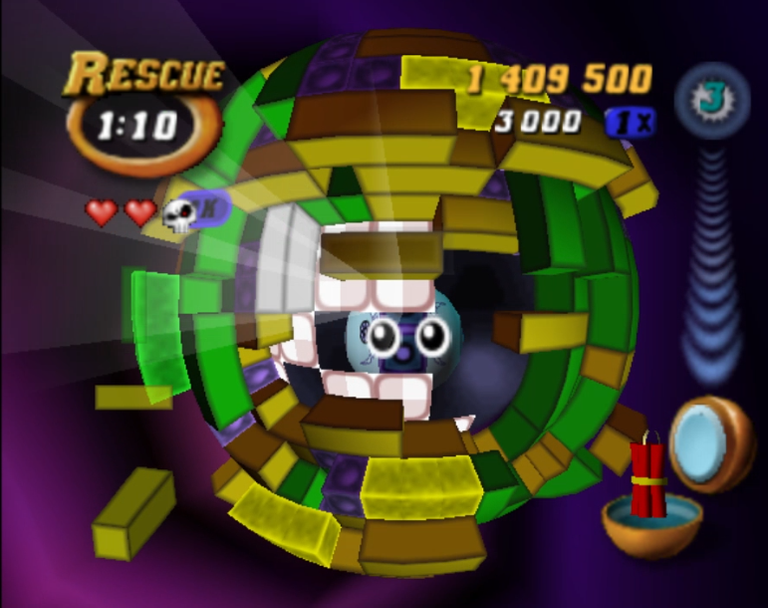

So you've seen me talk already about many versions of Tetris (with one of my first posts even being solely dedicated to talk about the huge variety and difference between most of them), including Tetris Attack which isn't even a Tetris game (don't ask me why it has "Tetris" on it). However, if there's a "Tetris" game that does go often overlooked and in my opinion underrated, its none other than Tetrisphere. And no, it is not literally playing Tetris on a screen with a fisheye/3D perspective; the gameplay is actually much more unique than the name suggests.
So...explaining how the game works is complicated to do in words, but the game actually includes a comprehensive basic tutorial (which is actually shown on the first time you boot the game) and tutorials for advanced techniques and the puzzle mode, so if you do want to try this game out, that tutorial explains it much better than I could think of. And as the presentation is another very striking aspect of the game for me, I will get that out of the way before diving straight into the gameplay itself. The game has a simple yet futuristic aesthetic as if everything was in space or came from it, you can select a robot for your player profile (my favorite is Stomp) which also apparently have stats that influence in VS mode matches, the game keeps a steady 30fps framerate (though might rise to 60fps at times)...and the music is absolutely something else, easily the second favorite aspect of the game for me. I really can't explain myself the soundtrack, but let me tell you that if you take a listen to it, you will definitely get entranced (specially if you hear it while playing the game).
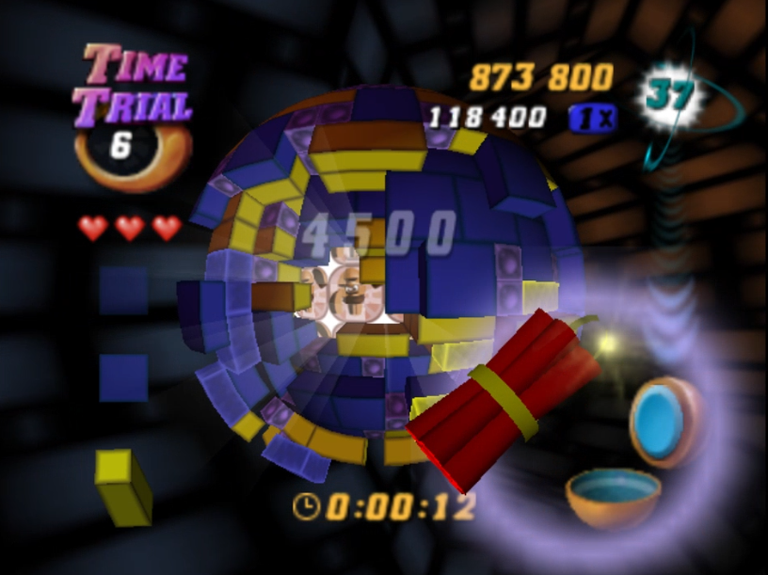
The basic gist of what I can put in words, is that you have to place the piece you get right at an adjacent side of another piece (or in the case of an T, L, S or Z piece, simply place it anywhere that lands on any connecting side of that piece), or on top of a same piece that's already connected to another identical piece or set of pieces, to make them explode in order to uncover the "cores" of the sphere (little squares below all the layers of the sphere). If this sounds confusing to determine, the piece shadow will change into a bright shape if you can drop the piece for a succesful explosion, but if you try to drop it without that, you will lose one of your three lives before an inmediate Game Over. With enough chains, you can also earn items like rockets, dynamite, and lasers, all of which can be used to destroy pieces or even entire layers on the sphere easily.
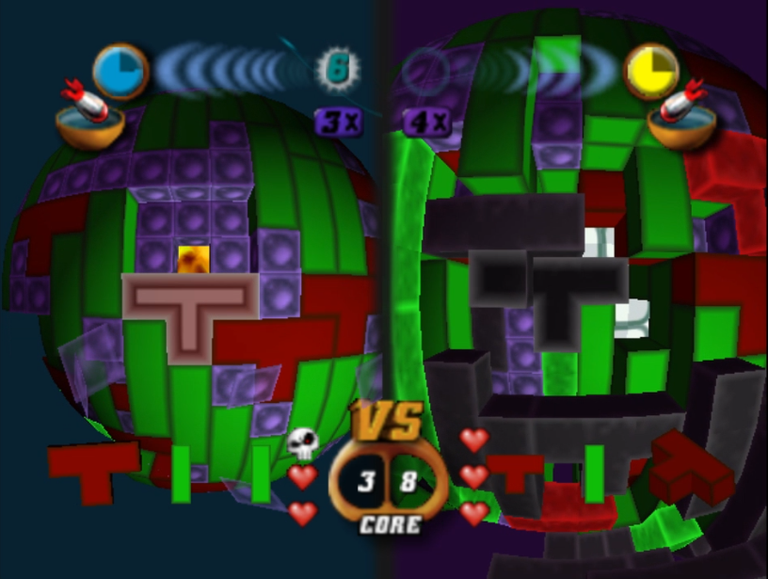
That said, once you do understand the gameplay (which again, I'm aware its confusing to explain, but going through the tutorial and game yourself, it makes a lot of sense), it shifts into a pretty creative and hectic puzzle game where, on top of trying to reach the center by dropping pieces in the right place, you can also slide pieces of the same shape by holding the B button, as well as sometimes getting a wildcard that can slide and place whatever piece you have below it. There's also the shiny "fuse blocks" which can be created from stray purple bricks by pressing B while having the shadow of a piece on top of them (like using a mold for cookies) or can simply turn like that on their own, and on top of being able to be moved upwards in layers instead of being locked on the same layer or downwards, exploding these causes a delayed chain reaction instead of blowing all pieces inmediately, and can be essential for chaining multipliers and delaying a deadly timer.
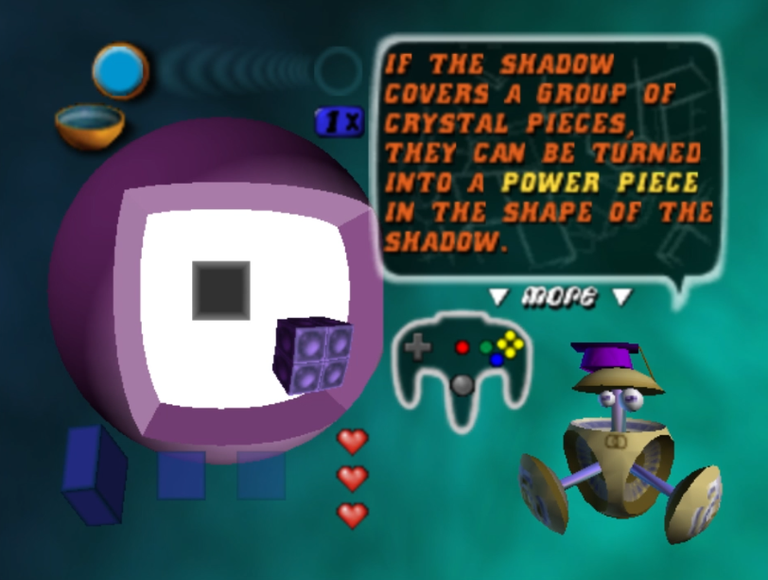
There's a lot of unpack from all what I just said, but there's also several modes which test different kinds of skills on the gameplay, like Rescue being exclusively uncovering enough cores to rescue the little guy trapped inside, Hide and Seek requiring you to clear a specific objective per level, Time Attack giving you 5 minutes to get the highest score, Vs. CPU which has you compete in versus matches to see who can uncover a set amount of cores before the other player can (and can send garbage to the enemy), and Puzzle...which is a bit more complicated to explain. In the rest of the modes though, as you progress in Episodes, either the timer that inmediately takes away a life from you which runs out starts decreasing really fast (and you can only delay it by clearing pieces quickly), the Hide and Seek objectives get more complicated with the timer still getting strict, and the computer in VS. CPU gets extremely agressive at playing. The only one where immediate pressure is left entirely up to you is in Time Attack, where figuring out how to play fast enough to get enough points is all what you have as an obstacle.
There's also a Practice mode separate from the single player modes which basically lets you play with no timer, setting the amount of layers on the sphere and cores needed to uncover, and set which pieces you want enabled. It looks like a good practice tool between having literally zero pressure by the timer and customizing if you want a quick and easy play, a simple-looking yet arduous gauntlet of trying to clear 99 cores on a sphere, or go nuts and try to play with ALL 7 pieces on a sphere...which I tried once and is unusually stupid to play with and probably explains why I don't ever recall any single player level doing this as well, as I had to spend more time finding pieces to clear more than anything as having all pieces at once made finding matching pieces a harder time (while thankfully the timer was disabled).
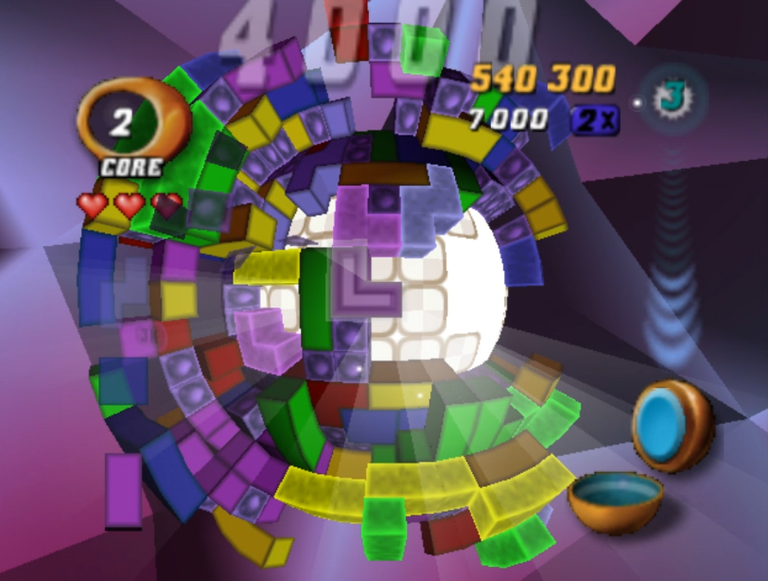
And Puzzle mode...is about clearing puzzles, sometimes where you have to drop a piece in the right place, and other times where you simply have to slide a piece for the other pieces to have a reaction and explode all of them...but it is definitely a big headscratcher rather than a adrenaline-fueled burst that the rest of the game has, since you have a limited slide and drop number, which means that as you are reaching level 50 out of the 100 puzzle levels, it will definitely have you squeezing your brain to get all pieces gone. Aside from the two player mode that I never had a chance to play because no one I knew had an idea about how the game worked, Puzzle mode is probably the most odd mode that basically turns into a different game entirely from what everything else gave you.
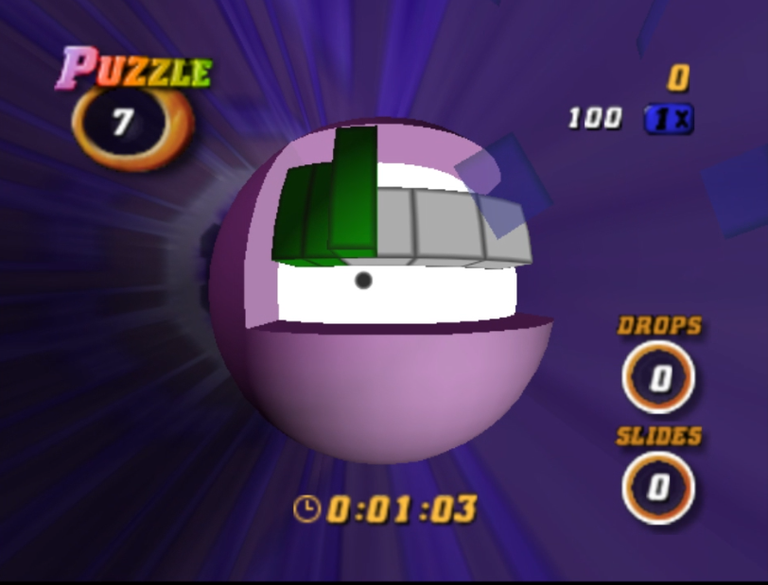
In the end, what is so special about this game that I've dedicated myself to talk this much about it even though most of the game only really makes sense when trying it yourself, definitely would be a combination of things. As with a couple other of specifically odd games I've talked about before, I owned this one for the Nintendo 64, and I remember stuff like the robot with the rocket on its hand in the cartridge label always calling my attention, picking Stomp the robot for my character only to see it happily jump around every time I cleared a level, the insane soundtrack which I've always liked to hear with MP3 files ever since I played it the first time (or even with the console itself through the Sound Test), and a similar case to what happened with me and AeroGauge in that the strange yet incredibly unique gameplay is such a satisfying thing to master...but in this case, it is not about learning the controls that makes the short experience worth it, no, this game packs A LOT of stuff to play through its various modes, doesn't pull your leg with AI when trying to win as most stuff is solo (VS CPU aside, but even then that still felt more like a challenge rather than an one-sided race on the harder episodes), the way you can push yourself even faster to moving pieces around and causing reactions is extremely satisfying yet tied to your reflexes...and it does grant you the satisfaction of "completion" as the game is not an infinite puzzle game, meaning there's an start and an end to every level you play, and after completing enough episodes in a mode, you will be greeted with the credits with easily one of the best songs I've EVER heard in a videogame at all (in my opinion), specially with how well it fits as an epilogue to all the hard work you've put down to challenge, survive and master this game.
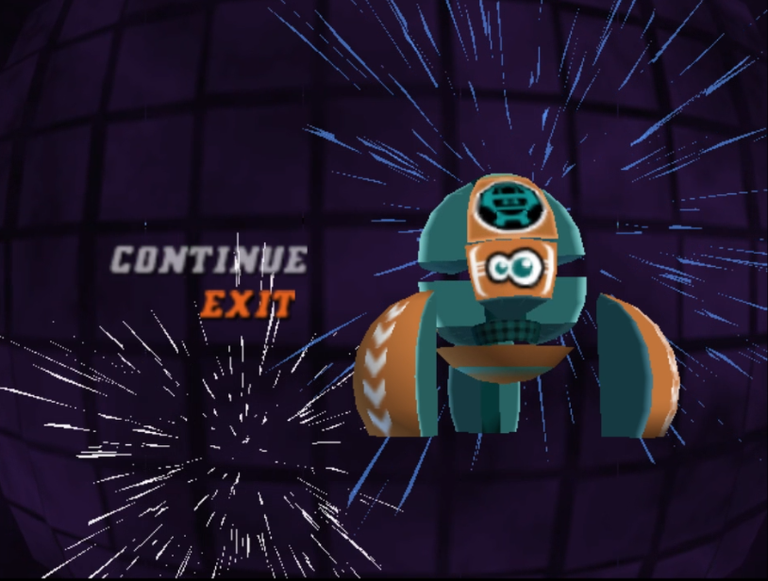
Is it likely that people will read all of this? I'm not sure...but it feels good to have written that big last paragraph out of my heart from everything I remember from playing it not only on my Nintendo 64 as a kid and actually enjoying the heck out of it (unlike AeroGauge which I gave away too soon to understand how to play it back then) and then revisiting it thanks to emulation. And I do feel that as I've recently reached 20 years of life, having written a piece of tribute to this game after how much it impacted me and how much I enjoyed it, feels like a satisfying circle to close. To everybody that has been supporting me since last year (including the @hivegc staff, the people I've met here at HiveGaming, and @crazy-andy for selecting my stuff for @curangel), thank you so much. To all who worked on this game, wherever they are (as well as the composer Neil Voss for the amazing music he made for this game), and everybody else that has developed videogames, both all I've talked about and those that I still would like to try again, thank you.
And to you, dear reader, whoever you are and wherever you are, thank you so much for reading.

Spanish translation with DeepL. All screenshots were captured by myself.
Español
Ya me habéis visto hablar de muchas versiones de Tetris (incluso uno de mis primeros posts se dedicó exclusivamente a hablar de la enorme variedad y diferencia entre la mayoría de ellas), incluyendo Tetris Attack que ni siquiera es un juego de Tetris (no me preguntéis por qué lleva "Tetris"). Sin embargo, si hay un juego de "Tetris" que sí suele pasar desapercibido y, en mi opinión, infravalorado, no es otro que Tetrisphere. Y no, no se trata de jugar literalmente al Tetris en una pantalla con perspectiva ojo de pez/3D; el modo de juego es, en realidad, mucho más singular de lo que su nombre sugiere.
Así que... explicar cómo funciona el juego es complicado de hacer con palabras, pero el juego en realidad incluye un completo tutorial básico (que de hecho se muestra la primera vez que arrancas el juego) y tutoriales para las técnicas avanzadas y el modo puzzle, así que si quieres probar este juego, ese tutorial lo explica mucho mejor de lo que yo podría pensar. Y como la presentación es otro aspecto muy llamativo del juego para mí, me quitaré eso de encima antes de sumergirme directamente en la jugabilidad propiamente dicha. El juego tiene una estética sencilla pero futurista, como si todo estuviera en el espacio o viniera de él, puedes elegir un robot para tu perfil de jugador (mi favorito es Stomp) que, al parecer, también tiene estadísticas que influyen en los combates del modo VS, el juego mantiene una velocidad de fotogramas constante de 30 fps (aunque puede llegar a 60 fps en algunos momentos)... y la música es absolutamente algo más, fácilmente el segundo aspecto favorito del juego para mí. Realmente no puedo explicar la banda sonora, pero déjame decirte que si la escuchas, definitivamente te quedarás embelesado (especialmente si la escuchas mientras juegas).

La esencia de lo que puedo poner en palabras, es que tienes que colocar la pieza que consigues justo en un lado adyacente de otra pieza (o en el caso de una pieza T, L, S o Z, simplemente colocarla en cualquier lugar que caiga en cualquier lado de conexión de esa pieza), o encima de una misma pieza que ya está conectada a otra pieza idéntica o conjunto de piezas, para hacerlas explotar con el fin de descubrir los "núcleos" de la esfera (pequeños cuadrados debajo de todas las capas de la esfera). Si esto parece confuso de determinar, la sombra de la pieza cambiará a una forma brillante si puedes dejar caer la pieza para una explosión exitosa, pero si intentas dejarla caer sin eso, perderás una de tus tres vidas antes de un Game Over inmediato. Con suficientes cadenas, también puedes ganar objetos como cohetes, dinamita y láseres, todos los cuales pueden usarse para destruir piezas o incluso capas enteras de la esfera fácilmente.

Dicho esto, una vez que entiendes el modo de juego (que, de nuevo, soy consciente de que es confuso de explicar, pero al pasar por el tutorial y el juego por ti mismo, tiene mucho sentido), se convierte en un juego de puzles bastante creativo y agitado en el que, además de intentar llegar al centro dejando caer las piezas en el lugar correcto, también puedes deslizar piezas de la misma forma manteniendo pulsado el botón B, así como a veces conseguir un comodín que puede deslizarse y colocar cualquier pieza que tengas debajo. También están los brillantes "bloques fusibles", que pueden crearse a partir de ladrillos morados perdidos pulsando B mientras se tiene la sombra de una pieza encima (como si se usara un molde para galletas) o simplemente pueden girar así por sí solos, y además de poder moverse hacia arriba en capas en lugar de quedar bloqueados en la misma capa o hacia abajo, hacerlos explotar provoca una reacción en cadena retardada en lugar de hacer volar todas las piezas inmediatamente, y puede ser esencial para encadenar multiplicadores y retrasar un temporizador mortal.

Hay mucho que descifrar de todo lo que acabo de decir, pero también hay varios modos que ponen a prueba diferentes tipos de habilidades en el juego, como el Rescate que consiste exclusivamente en descubrir suficientes núcleos para rescatar al pequeño atrapado en su interior, el Escondite que requiere que despejes un objetivo específico por nivel, el Contrarreloj que te da 5 minutos para conseguir la mayor puntuación, el Vs. CPU que te hace competir en partidas versus para ver quién puede descubrir una cantidad determinada de núcleos antes que el otro jugador (y puede enviar basura al enemigo), y Puzzle... que es un poco más complicado de explicar. Sin embargo, en el resto de los modos, a medida que avanzas en los Episodios, el temporizador que te quita inmediatamente una vida que se agota comienza a disminuir muy rápido (y sólo puedes retrasarlo eliminando piezas rápidamente), los objetivos de Escondite se complican con el temporizador que sigue siendo estricto, y la computadora en VS. CPU se vuelve extremadamente agresivo en el juego. El único en el que la presión inmediata se deja totalmente en tus manos es en Time Attack, donde averiguar cómo jugar lo suficientemente rápido para conseguir suficientes puntos es todo lo que tienes como obstáculo.
También hay un modo de práctica separado de los modos para un jugador que básicamente te permite jugar sin temporizador, fijando la cantidad de capas de la esfera y los núcleos necesarios para descubrir, y establecer qué piezas quieres habilitar. Parece una buena herramienta de práctica entre tener literalmente cero presión por el temporizador y personalizar si quieres un juego rápido y fácil, un guante de aspecto simple pero arduo de tratar de despejar 99 núcleos en una esfera, o volverte loco y tratar de jugar con TODAS las 7 piezas en una esfera... que probé una vez y es inusualmente estúpido de jugar y probablemente explica por qué no recuerdo ningún nivel de un solo jugador haciendo esto también, ya que tuve que pasar más tiempo encontrando piezas para despejar más que nada, ya que tener todas las piezas a la vez hizo que encontrar piezas coincidentes fuera más difícil (mientras que afortunadamente el temporizador estaba desactivado).

Y el modo Puzzle... se trata de despejar puzzles, a veces en los que tienes que dejar caer una pieza en el lugar correcto, y otras veces en las que simplemente tienes que deslizar una pieza para que las otras piezas tengan una reacción y exploten todas... pero definitivamente es un gran rompecabezas más que una explosión de adrenalina que tiene el resto del juego, ya que tienes un número limitado de deslizamientos y caídas, lo que significa que a medida que vas llegando al nivel 50 de los 100 niveles de puzzle, definitivamente te tendrá exprimiendo el cerebro para conseguir eliminar todas las piezas. Aparte del modo para dos jugadores, al que nunca tuve la oportunidad de jugar porque nadie que yo conociera tenía idea de cómo funcionaba el juego, el modo Puzzle es probablemente el más extraño, que básicamente se convierte en un juego totalmente diferente a lo que te daba todo lo demás.

Al final, lo que tiene de especial este juego para que me haya dedicado a hablar tanto de él aunque la mayor parte del juego sólo tiene sentido si lo pruebas tú mismo, sería definitivamente una combinación de cosas. Al igual que con otro par de juegos específicamente extraños de los que he hablado antes, tuve este para la Nintendo 64, y recuerdo que cosas como el robot con el cohete en la mano en la etiqueta del cartucho siempre me llamaban la atención, elegir a Stomp el robot para mi personaje sólo para verlo saltar alegremente cada vez que superaba un nivel, la demencial banda sonora que siempre me ha gustado escuchar con archivos MP3 desde que lo jugué por primera vez (o incluso con la propia consola a través del Sound Test), y un caso similar al que me ocurrió con AeroGauge en el sentido de que la extraña pero increíblemente única jugabilidad es algo tan satisfactorio de dominar. .. pero en este caso, no se trata de aprender los controles lo que hace que la corta experiencia valga la pena, no, este juego contiene MUCHAS cosas para jugar a través de sus diversos modos, no te toma el pelo con la IA al tratar de ganar ya que la mayoría de las cosas son en solitario (VS CPU aparte, pero incluso entonces eso todavía se sentía más como un desafío en lugar de una carrera de un solo lado en los episodios más difíciles), la forma en que usted puede empujar a ti mismo aún más rápido para mover las piezas alrededor y causar reacciones es extremadamente satisfactorio, pero atado a sus reflejos. ...y te da la satisfacción de haber completado el juego, ya que no es un juego de puzles infinito, lo que significa que hay un principio y un final para cada nivel que juegas, y después de completar suficientes episodios en un modo, serás recibido con los créditos con fácilmente una de las mejores canciones que JAMÁS he escuchado en un videojuego (en mi opinión), especialmente con lo bien que encaja como epílogo a todo el duro trabajo que has puesto para desafiar, sobrevivir y dominar este juego.

¿Es probable que la gente lea todo esto? No estoy seguro... pero se siente bien haber escrito ese gran último párrafo de corazón por todo lo que recuerdo de haberlo jugado no sólo en mi Nintendo 64 de niño y haber disfrutado de verdad (a diferencia de AeroGauge, que regalé demasiado pronto para entender cómo se jugaba en ese entonces) y luego volver a visitarlo gracias a la emulación. Y siento que al haber llegado recientemente a los 20 años de vida, el haber escrito un artículo de homenaje a este juego después de lo mucho que me impactó y lo mucho que lo disfruté, se siente como un círculo satisfactorio para cerrar. A todos los que me han apoyado desde el año pasado (incluyendo el personal de @hivegc, la gente que he conocido aquí en HiveGaming, y @crazy-andy por seleccionar mis cosas para @curangel), muchas gracias. A todos los que han trabajado en este juego, estén donde estén (así como al compositor Neil Voss por la increíble música que ha hecho para este juego), y a todos los demás que han desarrollado videojuegos, tanto todos los que he comentado como los que aún me gustaría volver a probar, gracias.
Y a ti, querido lector, seas quien seas y estés donde estés, muchas gracias por leer.

Traducción al español hecha con DeepL. Todas las fotos capturadas por mí.
No conocí el juego hasta que comentaste que lo jugaste, ni siquiera sabía que en N64 había juegos de Tetris y menos tan curiosos haha, a pesar de eso, entiendo perfectamente lo mucho que dices haberlo disfrutado de niño, yo no tuve nada parecido en mi N64, pero entre GoldenEye 007 y Donkey Kong 64 fui feliz durante mucho tiempo.
Sobre el Tetrisphere, aunque a veces juego al "Tetris de toda la vida" no tengo la menor idea de cómo se juega este, tienes un punto en que es complicado de explicar si no tienes un ejemplo práctico como puede serlo el tutorial, pero por eso mismo quiero entenderlo, así que eventualmente lo jugaré a ver que tal.